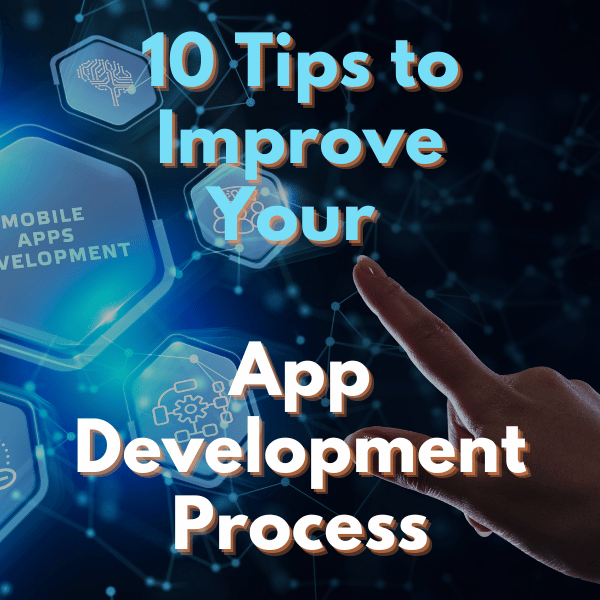Most of the time, the difference between a successful app development process and an unsuccessful one is in the way things get done. A winning project is characterized by efficient phases and best practices right from the start to the finish line, while an unfruitful one lacks these.
In light of that, for you to always achieve better results from your app development process, you must infuse efficiency as well as adopt some proactive strategies when taking all the necessary steps. So, how exactly do you do that? Check out the 10 tips for enhancing your app development right below. But before that, let us clear out what app development process is.
What Is an App Development Process?
The app development process is the act of creating applications for different devices. It entails an array of phases, for instance, coding, testing, and deployment to relevant platforms. To get the best results, developers have to adopt useful tips during the different stages of app development.
The App Development Process
To ensure effective results, the app development process needs to be broken down into systematic phases. Without pre-planned phases, it’s difficult to keep track of quality, and some bugs may not be observable until the final stage.
Because of this, the app might need much more time to develop, which leads to delays and missed deadline. So it all comes down to the development team forming a concrete plan before they begin the process.
Considering this information, it is safe to assume that the app development process is an integral component that determines the application’s overall quality.
However, what is this process, and what steps does it involve? Let’s dive into each step in detail to bette understand what it entails
1: Requirement Analysis
With every plan, the first step should involve establishing the foundations and defining the boundaries you have to stay within. In this case, the first step is to decide on a proper strategy when going forward.
This is important because adopting a proper strategy when developing the app will help you set goals for the app.
In addition to that, the requirement analysis also requires setting expectations based on which the app will perform.
This means setting a foundation based on which you’ll develop the app. In this way, the analysis is a key aspect of the app development process.
2: Design

When designing an application, organizations should aim to improve the overall look of the app so that it fits the aesthetic and theme they are looking to achieve. The theme is based on the latest trends, which will establish the app’s relevance.
In addition to that, this section of the process is focused on the UI/UX part of the application as well. Working on the UI/UX design of an application involves improving and optimizing it in order to remove redundancies created within menus and lists integrated into the app.
UX refers to user experience and involves what the user encounters when using your application. When working on this part of the design, designers want to make changes so that the application is as user-friendly as possible without compromising on the application’s main features.
The end product, after having gone through this aspect of the process, should be an intuitive app that ensures user-friendly interaction without the user having to skim through a cumbersome menu before finding what they are looking for.
3: App Development
Now comes the meat of the whole development process, and arguably one of the most important steps, which dictates if the app will make it or not.
During the app development step of the process, there are three main components that the organization focuses on: server technology, the API with which the app will be developed, and the front-end programming of the application.
Server Technology
This is an integral part contributing to app development because the selection and use of proper server technology will determine the application’s functionality.
This is because the main functions of the application are supported by a complex database and certain programs and objects located on the server, making server technology a supporting pillar of app development.
API
The API, also known as the application programming interface, is a mechanism that is essential to an application.
This is because it is the API’s job to ensure seamless communication between the software components, which is normally done by adopting certain methods known as protocols.
The presence of API integration in an application is very important because it ensures proper functionality of the application and ensures that the application properly communicates with other programs and the server the application is running on.
Front-end
By definition, front-end programming involves coding and implementing all the features that are visible to the user as they navigate through the application. This means programming the different menus, lists, and other display features.
Most applications offer an interactive experience to the user in order to engage them and increase traffic on the app. This is determined by how well front-end programmers develop the app.
4: Testing
After working on the UI/UX design features and the overall development process in order to create the application, it goes through extensive testing in order to verify if the app fulfills all the expectations and goals that it sets in the requirement process.
This is the QA department’s job, so they ensure that the application meets standards set by the organization as a whole. Additionally, testing also helps ensure that the application is usable and stable as well.
Quality assurance also point out bugs they come across while operating the application. It allows them to give programmers and designers feedback that is necessary for improving the application.
5: Deployment
After the application has gone through several possible iterations in order to come up with the final version, approved by the quality and assurance department, now comes the time to deploy the app to the app stores to be available for the public to use.
Famous app store platforms which have captured most of the market when it comes to launching apps are the Google play store and the apple app store due to their presence on the two most popular operating systems.
These are the two most famous app stores, but other stores also exist, and sometimes developers tend to launch their apps on those platforms as well. This may be due to promotional or exclusivity reasons, but some apps are also available on a single app store.
However, before using these applications, one has to make sure that they have a registered developer account in order to use these mobile applications.
10 Tips for Enhancing Your App Development Process
Here are some essential things to do to ensure that your app development process is a success.
App Development is one of the best ways to gain further exposure to your company. Google Searching for app development near me can help you find someone local.
1. Discuss Project Requirements in Depth

On the other side, as a developer, it is essential to offer consultations to all of your clients. Sales representatives can come in handy on such occasions by scheduling phone calls or emails to prospective customers. During their communication, they can gather any necessary information from the customers. And, with that done, they can create proposals for the clients as well as breakdowns of the development process.
2. Gather Business Insights and Provide Estimates
After discussing project requirements, it is time to hold the first team meeting. This gathering is essential when it comes to identifying the personnel to work on the project. Moreover, it helps the different players to get a chance to provide their opinion on a specific application. Typically, one of the first things to be done during such meetings is to bring the QA team on board and determination of the test case availability. By getting the QA involved early on, it enables them to comprehend the specifications of the customer way better. At this meeting, any issues regarding the flow of activities clear out.
After that, the QA will move straight to the development of test cases. When making these estimations, it is best to consider as many positive and negative test scenarios as possible. That said, there is also a need to make a test plan document to solidify the objectives and sketch the scope. This way, better cost estimations can be made while also getting an excellent idea of the project.
3. Always Sign an NDA
App development is a vital issue and should be taken as seriously as possible. Therefore, upon the completion of the steps above, it is time to make your app development official by signing an NDA agreement. This way, you can be sure that whatever information or idea you have provided to the developers is safeguarded.
Most of the time, real work on your application begins upon signing this agreement. It is understandable since this binding document is what details the methods of correspondence to be used, project requirements, file sharing modes, the forecasted milestones after specific durations, among other essential things.
4. Remember to Wireframe
Wireframing is the designing of an application at a structural level. Usually, a wireframe is used for laying out content and functionality while considering the needs of users. Wireframes are created early in the development process ahead of adding visual representations and content. With one, you can quickly get an idea regarding the development of timeframe while also refining and rearranging your strategies to allow smooth sailing during the development.
In this phase, ensure that you have an excellent comprehension of how your planned features, and development ideas will fit onto one another to create a functioning system. Moreover, it is essential to make a storyboard of sorts to lay out the connections between different screens and how users will maneuver while using your application. Be on the alert to ensure that you identify any opportunities to integrate your brand. And if nothing else, pay attention to user experience, taking into consideration different ways in which people will interact with your application.
5. Pay Attention to the UI/UX Design
The user interface (UX) expert is responsible for developing the interaction among the various design elements, on the one hand. On the other, the user interface (UI) professional’s task is creating the overall look and feel of an application.
Consider creating a questionnaire to assist with laying out ideas on the UX/UI design, for instance:
- The colors on the application.
- Functional font scheme.
- What already existing applications should be copied?
UI/UX Designers can leverage app design tools such as Adobe XD and Sketch to create sample screens. Often, the screens will have the application’s icon, sign up forms, login areas, and a home page. Then no matter what is the number of UI/UX designs being presented, you can pick your favorite and go on with the rest of the development process.
Note, just like other aspects of the app development process, handling UI/UX issues requires you to have a proper understanding of the functional and non-functional requirements of the same. This way, you can provide a working application that delivers the right features without having to compromise the outlook or usability.
6. Break Down Your Application Development into Sprints
After coming up with proper designs for the app, the actual building of the app, otherwise known as the coding process, begins. Every development team must have a project manager. And it is his or her job to define the process. That is, break it down into smaller tasks.
To create a successful app, the team must keep with agile development rules. Agile software development includes methodologies where requirements and solutions evolve based on collaboration between the cross-functional team and client or end-user. An agile environment enables communication to flow more smoothly. Features and functionalities will best suit the client’s needs as the customer gets to share their insights during development.
An essential tip for this phase is to set milestones. For a months-long process, you can break it down into two-week sprints. After every step, the team can present the work down thus far to the client and even create a demonstration. This way, you can identify a disconnect between what you are creating and what the customer actually wants early on and make the necessary adjustments. With this strategy, you will also have fewer changes to make once the app is complete. Also, ensure you have a timeline for each sub-development to get an idea about the expected delivery and costs.
7. Perform Thorough Quality Assurance Testing
Human error is quite common. While some of these mistakes are easy to fix, some are serious and even costly in the long run. There have been several cases in the recent history of software bugs being discovered and fixed later on.
Testing is not just necessary to keep the costs low but also helps to ensure the developed app is of high quality. The further you go into the development, the more it will cost to fix a bug. So, testing should go hand in hand with development. Once features are in the can, it undergoes testing to smoothen out the rough edges. There two types of software testing services: manual testing and automation testing, with each having its own advantages and disadvantages.
The best QA testing keeps the users’ experience in mind. Make it thorough by envisioning all the possible scenarios. How will the end-user use the app? What could the target customers potentially want in an app like the one you have created? Is there anything that they could do that would make the app crash? Design the test to fail. The harder a software test is to pass, the more effective it will be at identifying issues.
8. Build a Buzz around Your Mobile App Launch

You can also create a landing page for the app. It can simply be one page long with an opt-in form. That way, you can collect email addresses from visitors. Use these contacts to start an email marketing campaign and build interest in your app. This step will help you find early adopters that will anticipate the app long before it launches.
9. Have an App Store Optimization Plan
Now, before you submit the app to the store (Google Play or Apple Store), you’ll need to think about the app’s page on the store. Remember, many people discover the apps by searching specific words on the store’s search bar. You will need to find the perfect title, make a product description with the right keywords, and screenshots of the interface. There’s a set amount of characters. So, be wise with the keywords you select. Use a tool to analyze and compare different keywords. Keep SEO rules in mind to get maximum benefits.
Some development companies have in-house marketing departments that can help in creating descriptions and visuals for the app’s store page. Developers have a better knowledge of the Apple Store and Google Play Store policies and publishing regulations. They can also help you publish the application to the target app store. If you hire a development team to build your app, you can agree on this when signing the contract.
10. Gather Feedback for Post-Production Development
The last step of any app development process is maintenance. You need to work on app updates after the development, testing, and product launch. As technologies advance and people’s demands become more complex, your app will need new features. Remember, the moment the app goes into the users’ mobile phones, you’ll start to receive feedback. Take this feedback and utilize it in developing the next version of your app. Post-production development follows the same steps as the initial development process – only that it will be focusing on a specific feature or functionality. You can work out an after-launch plan with your developer.
Summary: Putting It All Together
Every step in the application development process is crucial for the development of the app.
- Requirements elicitation and validation at the inception stage;
- Then goes cost estimation;
- Afterwards, contract and NDA signing.
After that goes wireframes and initial designs that precedes an actual app building. QA testing goes on during and after development. Lastly, the app launches to the market.
These tips, combined with an experienced mobile product development team, will help you create an app that meets your requirements and users’ needs.

Author Bio
Angelo Frisina is a highly experienced author and digital marketing expert with over two decades of experience in the field. He specializes in web design, app development, SEO, and blockchain technologies.
Angelo’s extensive knowledge of these areas has led to the creation of several numerous award winning websites and mobile applications, as well as the implementation of effective digital marketing strategies for a wide range of clients.
Angelo is also a respected consultant, sharing his insights and expertise through various podcasts and online digital marketing resources.
With a passion for staying up-to-date with the latest trends and developments in the digital world, Angelo is a valuable asset to any organization looking to stay ahead in the digital landscape.


3 Comments
Personally thank you to Angelo Frisina for sharing these important points to improve mobile applications. Keep sharing this kind of blogs which always guide me to increase the businesses.
For selecting the best development company every business owner should check their project and business requirements. For my project I required an hourly basis developer and I chose moon technolabs for that.
Youre welcome Alicia. We appreciate your feedback!
This is mind blowing, thanks for sharing..